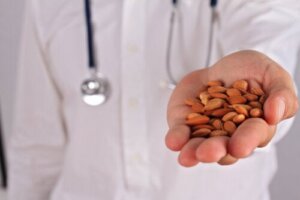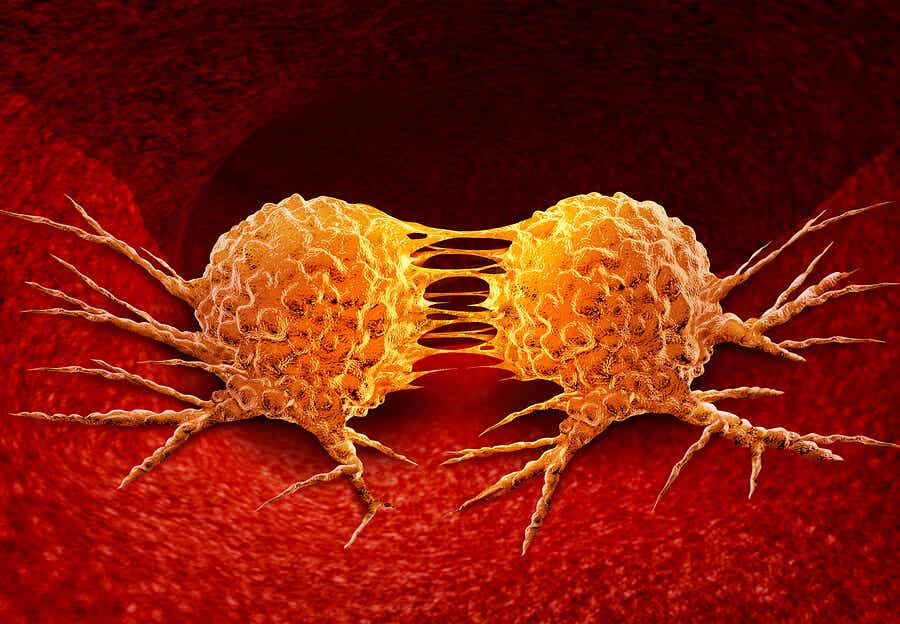Laetrile or Amygdalin: Uses, Properties and Risks


Reviewed and approved by the pharmacist Franciele Rohor de Souza
Laetrile is also known as amygdalin or vitamin B17. However, some experts disagree with the latter term, since this is actually a drug that contains purified amygdalin, extracted from the seeds of several plants belonging to the subfamily Amygdaloideae.
As detailed in an article in the National Library of Medicine, it’s found mainly in raw nuts, seeds, vegetables, and fruit pits, such as plums, apricots, and apples. Although it’s said to have medicinal properties, its use is controversial due to the lack of solid evidence. So what do you need to know about it?
Laetrile or amygdalin: what you need to know
Laetrile or amygdalin is the name of a drug that Dr. Ernst T. Krebs Jr. created in the 1950s. A review in the medical journal CA: A Cancer Journal for Clinicians comments that Krebs believed that this substance could “kill cancer cells”.
And although it became popular during the 1970s, it was banned in many U.S. states, as studies questioned its safety and efficacy. It was even reported to cause a high risk of cyanide poisoning, which can be very serious.
In nature, purified amygdalin is present in the following foods:
- Seeds: millet, flaxseed, and buckwheat.
- Raw nuts: bitter almonds, raw almonds, and macadamia nuts.
- Vegetables: carrots, celery, bean sprouts, beans, among others.
- Pits: of apricots, cherries, pears, and plums.
Now, although not approved by the Food and Drug Administration (FDA), it’s available in pill form or for intravenous or intramuscular injection. Many sites on the web have success stories about this treatment, but the truth is that science doesn’t back them up. In all cases, the risk of side effects is high.

You might be interested: Did You Know that Dried Fruit and Nuts can Help You Lose Weight?
Main uses of laetrile or amygdalin
The best-known use of laetrile has to do with its supposed anticarcinogenic potential. According to its proponents, it contributes to a mechanism known as apoptosis, which inhibits the growth of cancer cells.
The body breaks amygdalin down into three substances: hydrogen cyanide, benzaldehyde, and prunasin. According to a publication in the Cochrane Database of Systematic Reviews, hydrogen cyanide is the main anti-tumor compound of laetrile.
In particular, scientists have suggested three possible mechanisms of action against this disease:
- First, scientists thought that cancer cells contained enzymes that could transform amygdalin into cyanide. This would stop the cancer from growing. However, evidence overturned this hypothesis.
- Some also suggested that a deficiency of vitamin B17 (amygdalin) could affect the occurrence of cancer. Studies also disproved this, since amygdalin isn’t a vitamin and isn’t naturally present in the body.
- The last hypothesis suggested that hydrogen cyanide could cause cancer cells to become more acidic, which would result in their death. Regarding this, studies found that the substance destroys both healthy and malignant cells.
To date, research remains limited, and has only been performed in the lab and with animals. Moreover, the results are mixed and controversial. For now, scientists don’t consider it as a valid treatment option to fight cancer.
Other possible benefits
Much of the research on laetrile discusses its possible anti-tumor effects. Still, other research has determined that it may have different health benefits. However, it’s important to know that the evidence to support all of this is quite weak.
Lowering blood pressure
A study in the Journal of Al-Ma’moon College reported that amygdalin was helpful in lowering systolic blood pressure by up to 28.5%. Similarly, it reduced diastolic blood pressure by up to 25%. So, laetrile should have a positive effect on heart health.
Pain relief
Biological and Pharmaceutical Bulletin reports that amygdalin has an anti-inflammatory and analgesic effect. This means it’s been able to reduce the pain of conditions such as arthritis. Studies have been carried out in animals and human trials are needed.
Immunomodulator
Some scientists believed laetrile has the ability to stimulate immune system functions. In research reported in The Journal of Microbiology, Biotechnology, and Food Sciences, this substance enhanced the ability of immune cells to attach to prostate cancer cells.
Recent studies on laetrile
Several studies from recent years have focused on the anticarcinogenic effects of laetrile. One of them, reported in the International Journal of Nanomedicine in 2020, found that a combination of amygdalin with an enzyme called beta-glucosidase (ß-glu) helped eliminate prostate cancer cells.
The same year, a study in Current Molecular Pharmacology reported that amygdalin can kill certain breast cancer cell lines and, in turn, prevent their spread throughout the body.
The most recent study, published in March 2021 in the Journal of Biomolecular Structure & Dynamics, found that amygdalin induces apoptosis and has potential in cancer therapeutics. Still, the results weren’t conclusive.

Read also: 5 Tips to Help Prevent Prostate Cancer
Possible side effects
There’s also evidence related to the potential side effects that laetrile may cause, the most serious being hydrogen cyanide poisoning. Regarding this, clinical symptoms include the following:
- Nausea and vomiting
- Headaches
- Dizziness
- Bluish skin due to lack of oxygen
- Liver damage
- Abnormally low blood pressure
- Drooping upper eyelid (ptosis)
These symptoms tend to worsen if amygdalin is taken orally or together with vitamin C. Eating fruits, vegetables, or other food products that naturally contain the substance can also have an effect.
What should you remember about laetrile or amygdalin?
Laetrile, amygdalin, or vitamin B17 has been suggested as an alternative remedy against cancer. However, there’s no solid evidence to prove its effects on human health.
As a result, neither the FDA nor any other official regulatory body has approved it. On the contrary, they warn that consuming it carries serious health risks and recommended avoiding it.
All cited sources were thoroughly reviewed by our team to ensure their quality, reliability, currency, and validity. The bibliography of this article was considered reliable and of academic or scientific accuracy.
- National Center for Biotechnology Information (2021). PubChem Compound Summary for CID 656516, Amygdalin. Retrieved July 15, 2021 from https://pubchem.ncbi.nlm.nih.gov/compound/Amygdalin.
-
Unproven methods of cancer management. Laetrile. CA Cancer J Clin. 1991 May-Jun;41(3):187-92. doi: 10.3322/canjclin.41.3.187. PMID: 1902140.
- Bolarinwa, I. F., Orfila, C., & Morgan, M. R. A. (2014). Amygdalin content of seeds, kernels and food products commercially-available in the UK. Food Chemistry, 152, 133–139. https://doi.org/10.1016/j.foodchem.2013.11.002
- Milazzo, S., Ernst, E., Lejeune, S., & Schmidt, K. (2005). Laetrile treatment for cancer. In Stefania Milazzo (Ed.), Cochrane Database of Systematic Reviews. John Wiley & Sons, Ltd. https://doi.org/10.1002/14651858.cd005476
- GAL EM, FUNG FH, GREENBERG DM. Studies on the biological action of malononitriles. II. Distribution of rhodanese (transulfurase) in the tissues of normal and tumor-bearing animals and the effect of malononitriles thereon. Cancer Res. 1952 Aug;12(8):574-9. PMID: 14945048.
-
Biaglow, J. E., & Durand, R. E. (1978). The Enhanced Radiation Response of anin VitroTumour Model by Cyanide Released from Hydrolysed Amygdalin. International Journal of Radiation Biology and Related Studies in Physics, Chemistry and Medicine, 33(4), 397–401. https://doi.org/10.1080/09553007814550311
-
Greenberg DM. The case against laetrile: the fraudulent cancer remedy. Cancer. 1980 Feb 15;45(4):799-807. doi: 10.1002/1097-0142(19800215)45:4<799::aid-cncr2820450432>3.0.co;2-6. PMID: 6986971.
-
Hwang HJ, Kim P, Kim CJ, Lee HJ, Shim I, Yin CS, Yang Y, Hahm DH. Antinociceptive effect of amygdalin isolated from Prunus armeniaca on formalin-induced pain in rats. Biol Pharm Bull. 2008 Aug;31(8):1559-64. doi: 10.1248/bpb.31.1559. PMID: 18670089.
-
Halenár, M., Medveďová, M., Maruniaková, N., & Kolesárová, A. (2013). AMYGDALIN AND ITS EFFECTS ON ANIMAL CELLS. The Journal of Microbiology, Biotechnology and Food Sciences, 2, 2217-2226.
- Zhou J, Hou J, Rao J, Zhou C, Liu Y, Gao W. Magnetically Directed Enzyme/Prodrug Prostate Cancer Therapy Based on β-Glucosidase/Amygdalin. Int J Nanomedicine. 2020;15:4639-4657. Published 2020 Jun 29. doi:10.2147/IJN.S242359
- Al-Khafaji K, Taskin Tok T. Understanding the mechanism of amygdalin’s multifunctional anti-cancer action using computational approach. J Biomol Struct Dyn. 2021;39(5):1600-1610. doi:10.1080/07391102.2020.1736159
- Akyildiz BN, Kurtoğlu S, Kondolot M, Tunç A. Cyanide poisoning caused by ingestion of apricot seeds. Ann Trop Paediatr. 2010;30(1):39-43. doi: 10.1179/146532810X12637745451951. PMID: 20196932.
- Bromley J, Hughes BG, Leong DC, Buckley NA. Life-threatening interaction between complementary medicines: cyanide toxicity following ingestion of amygdalin and vitamin C. Ann Pharmacother. 2005 Sep;39(9):1566-9. doi: 10.1345/aph.1E634. Epub 2005 Jul 12. PMID: 16014371.
This text is provided for informational purposes only and does not replace consultation with a professional. If in doubt, consult your specialist.








